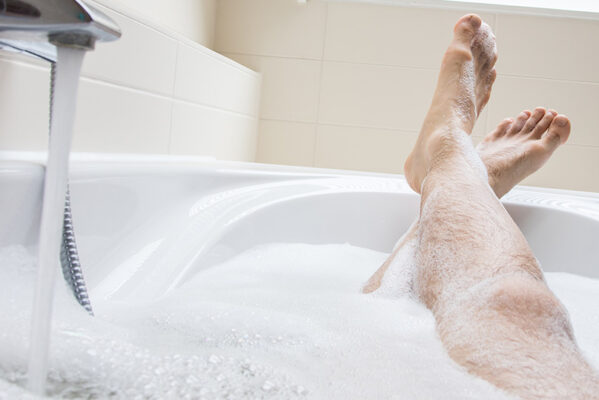A person with restless legs syndrome experiences twitchiness and discomfort in the legs, usually after going to bed. As this can lead to insomnia, it is considered a sleep disorder.
Restless legs syndrome (RLS) may happen because of mental or physical problems, or it may be an adverse effect of some medications. It is also known as Willis-Ekbom disease.
Restless legs syndrome may be classed as mild or severe, depending on the frequency and severity of the symptoms, how well the symptoms can be relieved by moving around, and how much disturbance they cause.
It affects up to 10% of people at some time during their life.
The vast majority of cases of RLS resolve on their own over time or once simple lifestyle changes have been made.
Symptoms
Symptoms can occur when a person is awake in a confined space, such as an airplane seat or at the cinema.
As RLS leads to difficulty falling asleep and staying asleep, the person may be tired during the day. This can have an impact on learning, work, concentration, and routine tasks and activities.
Lack of sleep can eventually lead to mood swings, irritability, depression, an undermined immune system, and other physical and health problems.
What does it feel like?
A person with RLS has a strange and unpleasant sensation in the legs, and sometimes the arms, and a strong urge to move them. People have described these feelings as:
- aching
- burning
- crawling
- creeping
- similar to electric shocks
- itching
- tugging
- tingling
The only way to relieve the discomfort is by moving the legs. The sensations tend to occur when the individual is resting or inactive and not only during the night. Symptoms often worsen in the evening and at night, and may be relieved for a short while in the morning.
How long will restless legs syndrome last?
Symptoms of primary or idiopathic RLS typically worsen over time, but, for some people, weeks or months may pass without any symptoms. If the RLS stems from a condition, illness, pregnancy, or medication, it may go away as soon as the trigger has gone.
Treatment
If a person cannot manage symptoms of RLS alone, they may be prescribed medications.

Medication
This will be discussed with your GP:
- Iron: If you have low iron levels. taking iron may help improve symptoms. Iron supplements are available to buy on line
- Painkillers: e.g Ibuprofen may help with mild symptoms.
- Anticonvulsants:-Such as Neurontin, or gabapentin.These treat pain, muscle spasms, neuropathy and daytime symptoms. .
- Benzodiazepines:These are sedative medications that help people with persistent and mild symptoms to sleep through the effects of RLS.
- Dopaminergic agents: These medications raise the levels of dopamine, a neurotransmitter, in the brain. They can treat the unpleasant leg sensations associated with RLS.
- Dopamine agonists: These also raise brain dopamine levels and treat unpleasant leg sensations. They may cause adverse effects in older patients, although some report more side effects with levodopa.
- Opiates: Treat pain affectively but highly addictive
Epilepsy and Parkinson’s drugs are sometimes used for RLS as they can reduce involuntary movements.
If certain underlying conditions triggers the RLS, and those conditions are treated, the RLS may go away or improve. This is often the case with iron deficiency and peripheral neuropathy.
Types
There are two main types of RLS:
Primary or idiopathic RLS
Idiopathic means that the cause is unknown.
It is the most common type and has the following characteristics:
- It usually begins before the age of 40.
- It can start as early as childhood.
- It may have a genetic cause.
- Once primary RLS starts, it tends to be lifelong.
Symptoms may be sporadic, or gradually worsen and become more prevalent over time.
In mild cases, the person may have no symptoms for a long time.
Secondary RLS
A secondary disorder is caused by another disease or condition.
Secondary RLS usually starts after the age of 45 years, and it does not tend to be hereditary. This types of RLS is distinctly different:
- Onset is sudden.
- Symptoms do not usually worsen over time.
- Symptoms may be more severe.
Diseases and symptoms that can trigger secondary RLS include:
- diabetes
- iron deficiency
- kidney failure
- Parkinson’s disease
- neuropathy
- rheumatoid arthritis
Exactly how RLS happens is not well understood, but it may be related to how the body processes dopamine, a neurotransmitter that plays a role in controlling muscle movements. Some medications, such as selective seratonin reuptake inhibitors (SSRIs) and anti depressants may trigger RLS. These drugs affect the activity of dopamine.
Periodic limb movement disorder (PLMD)
PLMD is a similarly related sleep disorder, sometimes called periodic limb (leg) movement during sleep (PLMS). In people with PLMD, the limbs twitch or jerk uncontrollably while sleeping. It is also considered a type of sleeping disorder. The movement may cause the individual to wake up frequently during the night, and this can undermine the quality and length of sleep. It can lead to RLS.
Home remedies
Lifestyle changes and common medications that may help alleviate RLS symptoms include:
- Warm baths and massages: These can relax the muscles and reduce the intensity of symptoms.
- Warm or cool packs: Some people prefer warm, some cold, and others say that alternating hot and cold is helpful.
- Relaxation techniques: Stress can make RLS worse, so exercises such as yoga, meditation, and tai chi may help.
- Exercise– using legs more can help alleviate symptoms. If the patient has a sedentary lifestyle, walking instead of driving, taking up a sport, or exercising the legs in a gym can help.
Sleep hygiene for restless legs syndrome
Sleep hygiene is important as being overtired makes symptoms worse.
Try:
- Sleeping in a cool, quiet bedroom.
- Going to bed at the same time every night, and getting up at the same time every morning.
- Reduce the amount of light you are exposed to for an hour before bed.
- Avoid stimulating drinks, such as caffeine or sugar.
- Avoid or reduce alcohol consumption and tobacco.
Exercise can help RLS, but it can also aggravate it. so stick to a moderate exercise regime.
Other things to try
There is some evidence that low levels of magnesium may ease the symptoms. Magnesium is available in whole grains, nuts, and green leafy vegetables.
Staying hydrated may also help. This can be achieved by drinking plenty of water and avoiding caffeine and alcohol.
Source medical newstoday
NHS website

